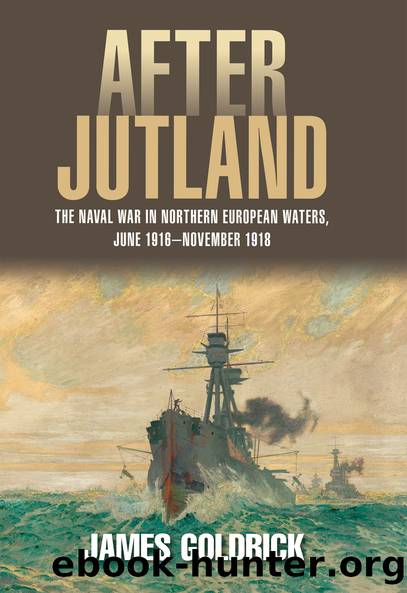After Jutland by Goldrick James;

Author:Goldrick, James; [Неизв.]
Language: eng
Format: epub
Tags: HISTORY / Military / World War I
Publisher: Pen & Sword Books Limited
Published: 2018-10-29T20:00:00+00:00
Operations of the Grand Fleet
Admiral Beatty was determined the Grand Fleet should make a greater contribution to the antisubmarine campaign than simply detaching destroyers to reinforce local forces. He yearned to go on the offensive, and if his intended approach did not derive from his passion for foxhunting, it certainly owed something to shooting game birds. The Admiralty had similar enthusiasm for an offensive approach. Operation BB proposed to employ destroyers as “beaters” to force U-boats passaging around the north of Scotland to dive. The hope was that having evaded the surface forces, they would surface to be attacked by submarines positioned farther south. Reasonable in theory, the operation from 15 to 24 June nevertheless took up fifty-three out of eighty-six available destroyers and their leaders, together with seventeen submarines. The British believed that they made twenty-six sightings and conducted eight destroyer and three submarine attacks. Some were against phantoms, although K1 may have succeeded in hitting U95 with a dud torpedo. In other encounters, the British submariners learned how difficult a target a submarine made; the need for surprise meant most attacks were conducted at very long ranges. J1 (no longer commanded by Laurence) fired four torpedoes at a surfaced U-boat at ranges between forty-five hundred and five thousand yards. They missed. The British believed the operation seriously interfered with the U-boats’ antishipping operations on the east coast and in the Norwegian Sea, but there is no evidence that it made any real difference. Furthermore, the operation’s scale meant it could not soon be repeated, although Beatty was eager to do so. The Grand Fleet had to content itself with less ambitious projects. Operation CC, conducted over five days beginning on 5 July attempted to integrate kite balloons with a small force of destroyers, five of which had balloons in tow. Deployed north of the Shetlands across one of the U-boats’ transit routes to the Atlantic, conditions were favorable, with the light winds and high visibility all too rare in that area. Arguably, they could not have been better for the hunting force. One submarine was sighted, but the U-boat concerned dived well before the destroyers could get into her vicinity. The price of the extended horizon of the kite balloon was its visibility at long range to an enemy observer on the surface. A second operation a few days later produced the sighting of a U-boat and an attack by the destroyer Patriot, which the British thought successful on the evidence of oil and an explosion underwater. The actual fate of the boat in question (U69) remains uncertain.
This period saw another important change. America’s entry to the war altered the nature of the blockade and made it much more a regime of port control than examination at sea. The units of the Tenth Cruiser Squadron were not required in the same numbers as before. They were also increasingly vulnerable to U-boats using the northern route and represented potentially useful merchant tonnage, as well as possible ocean convoy escorts. The squadron’s numbers were reduced in June 1917, initially to provide for Atlantic convoy work.
Download
This site does not store any files on its server. We only index and link to content provided by other sites. Please contact the content providers to delete copyright contents if any and email us, we'll remove relevant links or contents immediately.
| Africa | Americas |
| Arctic & Antarctica | Asia |
| Australia & Oceania | Europe |
| Middle East | Russia |
| United States | World |
| Ancient Civilizations | Military |
| Historical Study & Educational Resources |
Magic and Divination in Early Islam by Emilie Savage-Smith;(1450)
Ambition and Desire: The Dangerous Life of Josephine Bonaparte by Kate Williams(1274)
Papillon by Henry Charrière(1260)
Bohemians, Bootleggers, Flappers, and Swells: The Best of Early Vanity Fair by Bohemians Bootleggers Flappers & Swells- The Best of Early Vanity Fair (epub)(1256)
Twelve Caesars by Mary Beard(1135)
Operation Vengeance: The Astonishing Aerial Ambush That Changed World War II by Dan Hampton(1110)
What Really Happened: The Death of Hitler by Robert J. Hutchinson(1066)
London in the Twentieth Century by Jerry White(1047)
Time of the Magicians by Wolfram Eilenberger(1027)
Twilight of the Gods by Ian W. Toll(1021)
The Japanese by Christopher Harding(1017)
Lenin: A Biography by Robert Service(981)
The Devil You Know by Charles M. Blow(930)
Freemasons for Dummies by Hodapp Christopher;(889)
A Social History of the Media by Peter Burke & Peter Burke(883)
Napolean Hill Collection by Napoleon Hill(860)
The Churchill Complex by Ian Buruma(855)
The Rise and Triumph of the Modern Self by Unknown(852)
Henry III by David Carpenter;(847)
